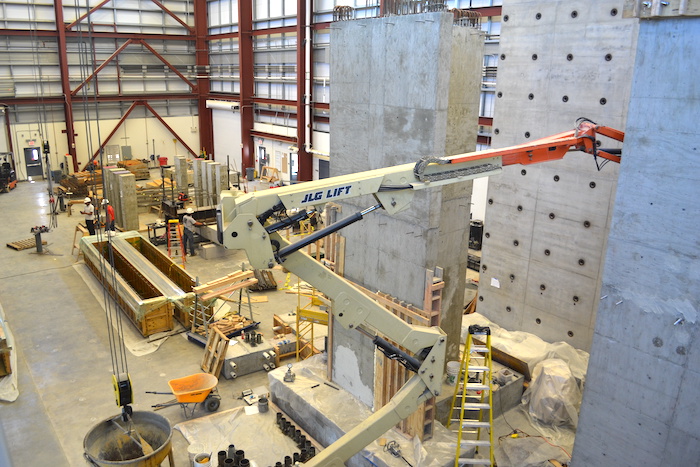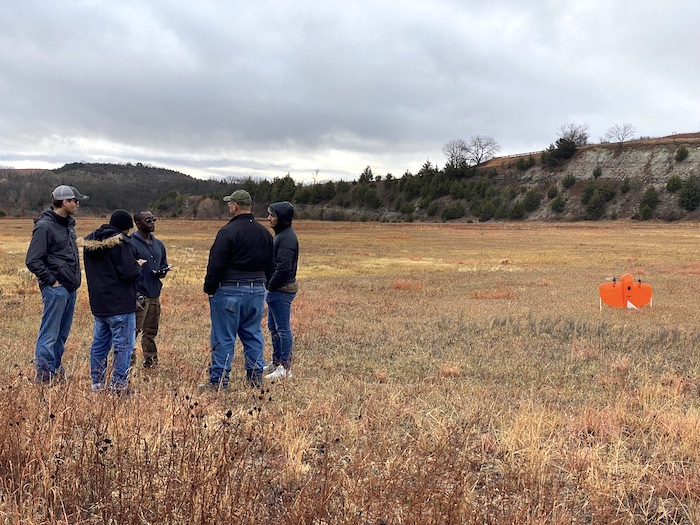KU researchers strengthen American dams, levees with technological innovation

LAWRENCE — A team of researchers at the University of Kansas School of Engineering has partnered with U.S. federal agencies in a push to reinforce American dams and levees nationwide using fiber-reinforced polymers, sensors, artificial intelligence and drones.
The $7.7 million, five-year project is a partnership between KU, the U.S. Army Engineer Research and Development Center (ERDC), the Department of Homeland Security’s Science and Technology Directorate and the U.S. Army Corps of Engineers.
Work at KU is headed by Caroline Bennett, Dean R. and Florence W. Frisbie Associate Chair of Graduate Studies, Glenn L. Parker Faculty Fellow and professor of civil, environmental & architectural engineering.

"The project focuses on developing repairs and retrofits for the inventory of concrete dams in the U.S., with an emphasis on efficient damage detection,” Bennett said. “In addition to repair methods, we’ll be using fiber-reinforced polymer materials, or FRPs, to address damage. Specifically, we’re targeting sliding at lift joints, restraining rocking between crest block and dam body during seismic loading, and damage on concrete spillways of dams. Our goal is to extend the usable lives of existing concrete dam infrastructure, which was mostly built in the 1930s and 1940s.”
These New Deal-era dams and levees aren’t just showing their age; several have experienced catastrophic failures in recent years due to disrepair. In 2005, New Orleans’ levees were breached with disastrous results during Hurricane Katrina, while levees in South Carolina were breached during Hurricane Matthew in 2016. A year later, relentless rain caused the Oroville Dam in California to fail. One recent assessment concluded the nation’s dams and levees need $93.6 billion in upgrades.
Before repairs are made, dams and levees must be assessed for repairs. KU researchers are developing new approaches for dam and levee damage-detection, which traditionally required people dangling from ropes. Their approach will rely on artificial intelligence, according to co-primary investigator Jian Li, Francis M. Thomas Chair’s Council Associate Professor of Civil, Environmental & Architectural Engineering at KU, who will lead much of that work.
“My main role is focused on using deep learning and computer vision to autonomously identify the location and severity of dam damage, such as concrete cracking and spalling, for which FRP repair is needed,” Li said. “Once the repair is done, these locations are no longer inspectable. Therefore, we’ll also develop self-sensing FRP repairs to enable continued monitoring of the repaired regions to ensure long-term safety. By leveraging emerging technologies including artificial intelligence, computer vision and advanced sensing, our research will greatly enhance timely repair, retrofit and maintenance of the nation’s large inventory of concrete dams.”
In the meantime, KU faculty, postdoctoral researchers, graduate students and undergraduate research assistants work to identify appropriate fiber-reinforced polymer materials for a unique application in concrete gravity dams. This materials characterization and large-scale testing work will take place in three different KU laboratories where enormous loads will be applied in flexible and direct-shear tests to measure the performance of the FRP repairs: the West Campus Structural Testing Facility, the Learned Hall Structural Engineering Testing Laboratory and the Lutz Fracture and Fatigue Laboratory.
Rémy Lequesne, associate professor of civil, environmental & architectural engineering, will lead large-scale experimental testing of simulated joints in concrete dams, both with and without repairs.
“As America’s infrastructure ages, it’s important we become better at assessing whether structures can continue to serve safely and also develop improved methods to repair and extend the service-life of structures,” Lequesne said. “This project does just that. We’re developing more efficient methods for dam inspection and, through data collection and model development, providing tools that engineers can use to make decisions about whether and how to repair existing dams. Results will lead to recommendations and new modelling tools that engineers can use for assessment and design of repairs.”
Meantime, investigators at KU will conduct a scholarly review of all research into FRP materials, information that will guide their own testing of the promising materials. Carbon-fiber materials, lightweight and stronger than steel in strength-to-weight ratio, hold potential to address the enormity of repairing and retrofitting many of the 700-plus dams and related structures the USACE operates and maintains.
“These materials typically begin as fabric and are commonly made of a matrix of glass or carbon fiber, along with an epoxy or resin material,” Bennett said. “This unique matrix gives the material great strength-to-weight properties, resistance to corrosion and the ability to be formed into various geometries to match the substrate being worked with. As a result, FRP materials offer a cool opportunity to create overlays that follow the geometry of the structure while remaining strong and lightweight."
According to Bennett, the goal of the work at KU is to boost American transportation and commerce, as well as safeguard nearby communities.
“Our systems of dams and levees is responsible for ensuring we have navigable waterways and that we have reliable water sources for drinking water as well,” she said. “This is hugely important infrastructure. We're not really building new dams anymore, so it has become critical to maintain our existing inventory of dams from both a safety perspective, for drinking water, as well as navigability of our waterways. It’s very important to the safe functioning of our infrastructure, from a life-safety standpoint, but also from an economic and transportation standpoint.”
Top photo: View of the KU West Campus Structural Testing Facility. Credit: Courtesy Caroline Bennett.
Right photo: Personnel from the University of Kansas and U.S. Army Corps of Engineers discuss collection of drone-based data pre-flight at the Tuttle Creek Spillway Structure in Manhattan. Credit: Courtesy Caroline Bennett.